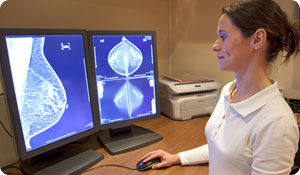
The Food and Drug Administration (FDA) just approved the first system for digital mammography. The FDA reports that in pre-clinical studies, 3-D mammography was seven percent more accurate than traditional mammography.
3-D Mammography
3-D mammograms, or digital breast tomosynthesis (DBT), overlays 3-D optical mammogram images with x-ray images. Radiologists say it helps differentiate benign lesions from malignant ones in a noninvasive way. This means fewer biopsies of non-cancerous lesions, fewer false positives, and a better understanding of the characteristics of the tumor or lesion. With current 2-D mammography, about 10 percent of women require additional imaging to clarify ambiguous results. This is particularly the case for women with dense breast tissue.
DBT reconstructs a series of thin, high-resolution, cross-sectional slices into 3-D images. While providing detailed image resolution, 3-D images don't show the contrasts between tumors and dense breast tissue very well, so radiologist overlay them with 2-D images to create a more detailed picture of the breast.
The Pros and Cons of 3-D Mammography
In initial experimental studies, the FDA found that although 3-D imaging improved cancer detection, researchers have not replicated these results in randomized control trials. So far, the United States Preventive Services Task Force, an independent agency, says the current evidence is insufficient to assess the additional benefits and harms of 3-D mammography.
In a large study, more than 49,000 women received both digital and screen film mammograms administered by the same technician. Researchers found insignificant differences in detection accuracy for the entire group. However, 3-D images were more effective for women with dense breasts, those younger than 50, and for pre- and peri-menopausal women.
There are downsides to 3-D mammography. Digital mammograms expose women to twice the radiation as traditional mammography, which is already high. According to cancer prevention expert Samuel S. Epstein, mammograms (two images of each breast yearly) expose women to .5 rad (radiation absorbed dose) annually. This is five times higher than the Environmental Protection Agency's allowable rad for whole body exposure from nuclear industries (.02 rad) and 500 times the dose from a single x-ray of the whole chest, not just the breast, which is the most sensitive organ to ionizing radiation.
Not all patients will benefit equally from 3-D mammography so physicians must determine who should take advantage of it. Furthermore, each manufacturer's system has its own benefits and disadvantages, which makes direct clinical comparison difficult. It also makes it hard to establish standardized exam protocols. 3-D mammography still requires the same breast compression as traditional mammography.
Sources:
"Combined X-Ray and Optical Tomography Improve Breast Imaging." Radiology. Medscape Medical News. Web. 9 November 2010.
http://www.medscape.com/viewarticle/732198
J Lin, MD, Lars Grimm, MD, MHS. "3D Mammography." Medscape Medical News. Web. 4 March 2011.
http://emedicine.medscape.com/article/1970908-overview
Hendrick, R. Edward, Pisano, Etta D., Averbukh, Alice, Moran, Catherine, Berns, Eric A., Yaffe, Martin J., Herman, Benjamin, Acharyya, Suddhasatta, and Gatsonis, Constantine. "Comparison of Acquisition Parameters and Breast Dose in Digital Mammography and Screen-film Mammography in the American College of Radiology Imaging Network Digital Mammographic Imaging Screening Trial." American Journal of Roentgenology 94(2) (2010): 362-369. Medscape Medical News. Web. 20 May 2010.
Fox, Steven. "FDA Approves First 3-Dimensional Mammography System." Medscape Medical News. Web. 14 February 2011.
http://www.medscape.com/viewarticle/737331
National Cancer Institute. "Mammograms." Web. 1 October 2010.
http://www.cancer.gov/cancertopics/screening/breast/mammogram
Samuel S. Epstein. "Breast Cancer Unawareness Month: Rethinking Mammograms." HuffingtonPost.com. Web. 15 October 2010.
http://www.huffingtonpost.com/samuel-s-epstein/the-breast-cancer-unaware_b_754641.html
Dr. William Campbell Douglass . "3-D mammograms present new risks for women." HealthierTalk.com. Web. 8 March 2011.
http://www.healthiertalk.com/3-d-mammograms-present-new-risks-women-3500





